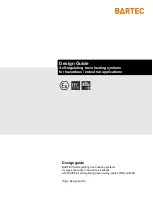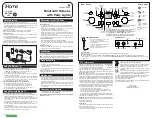
3.9.
SYSTEM PROTECTION
To provide a level of protection against faults such as short circuits or overheating, two safety
features are incorporated in the welder unit.
The auxiliary circuit is protected by a 1 Amp fuse located on the auxiliary transformer.
Two thermostats are built into the system to protect against overheating, the second providing a margin of safety should the first thermostat
fail. Regularly check the thermostats to ensure they are correctly in contact with adjacent parts.
3.8.
USING PORTABLE WIRE DRIVE Models 3500 & 4500. (fig 10).
Lift the side panel to access the drive unit.
Unplug the circular dinse connector and the adjacent square connector.
Undo the butterfly bolt that secures the unit.
The unit may be placed on top of the welder where location hole is to be found, and secured with butterfly bolt.
Re-connect the dinse and square connectors, and fit torch to the euro-connection on the portable unit (fig 10).
The wire drive may be used away from the welder with optional umbilical extensions.
Contact your local Sealey dealer to order:
3 metre umbilical lead assembly ask for 120/802271.
9 metre umbilical lead assembly ask for 120/802272.
4.7.
MACHINE SYMBOLS
Not all models will have
the same symbols
4.1.
Mig/Mag welding. (See fig 5, and fig 7 ).
A spool of welding wire is placed on spool holder and automatically fed
through an insulated liner in the torch to its tip. The torch consist of a switch, liner, gas hose, and control cable. The switch
activates the wire feed roller and the gas flow. Releasing the switch stops wire feed and gas flow. The weld current is transferred
to the electrode (the wire) from the contact tip at the torch end. Wire speed must be adjusted according to power output. The
higher the current the faster the wire speed. A gas cup fits over the contact tip to direct gas flow towards the weld ensuring the arc
welding process is shielded from oxidising air contamination (fig 11). The shielding gas also assists heating of the weld. The torch
is connected to the positive side of a DC rectifier, and negative clamp is attached to the workpiece.
4.2.
Preparation for Welding.
IMPORTANT:
BEFORE YOU COMMENCE, MAKE SURE THE MACHINE IS SWITCHED OFF AT THE MAINS. IF WELDING A CAR,
DISCONNECT THE BATTERY OR FIT AN ELECTRONIC CIRCUIT PROTECTOR. ENSURE YOU READ AND UNDERSTAND THE
SAFETY INSTRUCTIONS IN CHAPTER 1.
4.2.1. Connecting the Earth Lead
Models 2750, 3500 & 4500
Use the single return earth for steel up to 6mm in thickness, and the double return earth for steel over 6mm
Model 2500 only operates on a single return earth
To ensure a complete circuit, the earth lead must be securely attached to the work piece that is to be welded.
a) Best connection is obtained by grinding the point of contact on the workpiece before connecting clamp to the workpiece.
b) The weld area must also be free of paint, rust, grease, etc.
c) If welding a vehicle, disconnect vehicle battery or fit an Electronic Circuit Protector to battery, (available from your Sealey dealer).
4.2.2. Wire feed switch controls the speed of the wire feed. In principle, the lower the amperage number the slower the wire speed.
4.3.
Gas types and their use.
Welding mild steel with CO
2
gas is appropriate for most welding tasks where spatter and high build up of weld do not pose a problem.
To achieve a spatter free and flat weld however, you must use an Argon/CO
2
mixture.
To weld aluminium use:
3
Argon gas or Argo-Helium mixture,
3
0.8mm Contact Tip,
3
0.8mm Aluminium Wire, (MIG/2/KAL08).
4.4.
Spot Welding.
Remove the gas cup and fit a spot welding gas cup. Turn the power and wire speed to the highest setting allowed by your machine
and set the spot weld timer according to the thickness of the metal sheets. Drill a small hole in the top workpiece. Push the spot gas
cup onto the material to be welded (fig 12). The castelations on the cup keep it the correct distance from the weld pool and allow you
to push the two pieces being welded together. Press the torch trigger and hold until the pre set spot welding time has been achieved.
The wire will feed through during the allotted time and create the weld.
4.5.
Aluminium Welding.
Argon or an Argon-Helium mixture should be used for shielding. The wire used must have the same characteristics as the
material to be welded. Always use an alloy wire (i.e. aluminium/silicium); DO NOT use pure aluminium wire. A problem you
may experience when aluminium MIG welding is in pulling the wire for the whole length of the torch, as aluminium has poor
mechanical characteristics. The smaller the diameter of wire the more difficult the wire feed may be.To overcome this problem,
replace the torch guide hose with a Teflon guide hose. To withdraw the hose loosen screws at the end of the torch.
Use contact tip suitable for aluminium.
Replace the wire puller rollers with aluminium compatible rollers.
Replace the steel guide hose for wire feed with a Teflon guide hose. Contact your local Sealey dealer for information.
4.6.
Rivet Welding. (Fig 13).
Process to re-structure/re-shape dented or misshaped metal sheets, without the need to hammer sheet from behind. This is
useful when repairing inaccessible sections of bodywork.
Replace the torch nozzle with a rivet nozzle. This nozzle has a side inlet tube for housing the rivet.
Turn the current switch to position 3.
Adjust the wire speed according to the current and the diameter of the rivet.
Set the timer for 1 to 1.5 seconds.
A spot will take place at the point where the head of the rivet is located and will join the rivet to the metal. The rivet may
now be used as an anchor point in order to re-shape using appropriate appliances.
IMPORTANT.
Should you have no welding experience, we recommend you seek training from an expert source to ensure your personal health & safety.
You must familiarise yourself with welding applications and limitations, and specific potential hazards peculiar to welding. Good Mig welding may be achieved only
with continued, supervised practice.
4. WELDING PRINCIPLES
fig 11
fig 12
fig 10
fig 13
POWERMIG2500, 2750, 3500, 4500. - (0051) - (1) - 271000

























